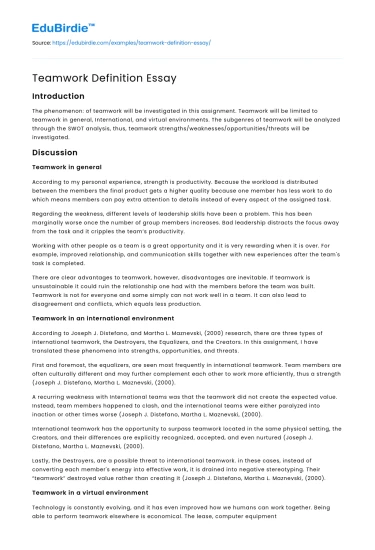Introduction
In the increasingly interconnected world of the 21st century, the concept of teamwork has emerged as a pivotal element in various fields, from business and technology to healthcare and education. At its core, teamwork is defined as the collaborative effort of a group to achieve a common goal or complete a task in the most effective and efficient manner. This definition, while straightforward, encompasses a complex interplay of interpersonal skills, communication, and shared responsibilities. The significance of teamwork cannot be overstated, as it not only enhances productivity but also fosters innovation and adaptability in dynamic environments. This essay aims to delve into the nuances of teamwork, examining its key components, challenges, and the impact it has on organizational success. Through a detailed exploration of these aspects, we will uncover the multifaceted nature of teamwork and its indispensable role in contemporary society.
The Key Components of Effective Teamwork
Effective teamwork is underpinned by several key components, each contributing to the seamless functioning of a team. One of the foremost components is communication, which serves as the lifeline of any team. According to Katzenbach and Smith (1993), effective communication involves not only the exchange of information but also active listening and feedback mechanisms that ensure clarity and mutual understanding. For instance, in the context of healthcare, a study by O’Daniel and Rosenstein (2008) highlights how effective communication among medical teams leads to improved patient outcomes and reduced errors. This underscores the critical role communication plays in enabling teams to coordinate efforts and achieve their objectives.
Save your time!
We can take care of your essay
- Proper editing and formatting
- Free revision, title page, and bibliography
- Flexible prices and money-back guarantee
Another fundamental component is trust, which forms the foundation of any collaborative endeavor. Trust fosters a sense of safety and openness, allowing team members to express ideas and concerns without fear of judgment. This is particularly important in creative industries, where innovation thrives on diverse perspectives and constructive debate. As articulated by Edmondson (1999), teams with high levels of trust are more likely to engage in "psychological safety," where individuals are encouraged to take risks and contribute to discussions freely. Furthermore, shared goals and mutual accountability are essential for aligning team efforts. When team members are committed to a common purpose and hold each other accountable, they are more likely to achieve synergy, where the collective output exceeds the sum of individual contributions.
Challenges and Counterarguments in Teamwork
While the benefits of teamwork are widely recognized, it is not without its challenges and potential pitfalls. One common challenge is the phenomenon of "social loafing," where some team members may contribute less effort, relying on others to carry the workload. This can lead to frustration and resentment, ultimately undermining team cohesion. To address this issue, clear roles and responsibilities must be established, ensuring that each member's contribution is visible and valued. Additionally, the implementation of regular performance evaluations can help mitigate social loafing by holding individuals accountable for their contributions.
Another challenge is the potential for groupthink, a psychological phenomenon where the desire for harmony and conformity in a team leads to poor decision-making and a lack of critical evaluation. Janis (1972) describes groupthink as a mode of thinking that people engage in when they are deeply involved in a cohesive in-group, and the strive for unanimity overrides their motivation to realistically appraise alternative courses of action. To counteract groupthink, teams should encourage diverse viewpoints and create an environment where dissent is not only tolerated but encouraged. This can be achieved through structured decision-making processes that prioritize critical thinking and independent analysis.
Despite these challenges, the advantages of teamwork, such as increased creativity, shared knowledge, and enhanced problem-solving capabilities, often outweigh the potential drawbacks. Moreover, with the advent of remote work and virtual teams, organizations are increasingly investing in technology and training to facilitate effective collaboration across geographical boundaries. This demonstrates a growing recognition of the importance of teamwork in achieving organizational success.
Conclusion
In conclusion, teamwork is a multifaceted construct that plays a critical role in achieving collective success across various domains. Its key components, including communication, trust, and shared goals, are essential for fostering collaboration and synergy among team members. Although challenges such as social loafing and groupthink can hinder team effectiveness, they can be mitigated through strategic interventions and a commitment to fostering an inclusive and dynamic team environment. As organizations continue to navigate the complexities of the modern world, the importance of cultivating effective teamwork cannot be overstated. By embracing the principles of teamwork, individuals and organizations alike can unlock their full potential, driving innovation, and achieving excellence in their respective fields.






 Stuck on your essay?
Stuck on your essay?

